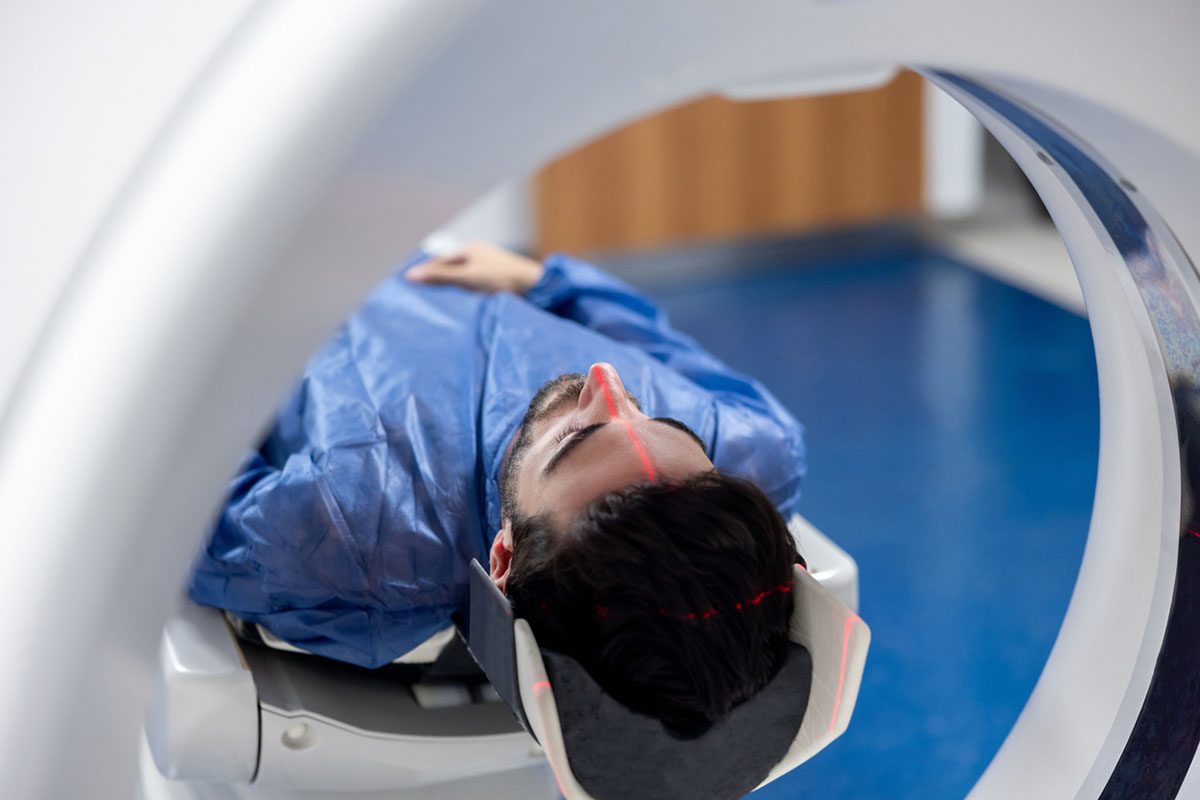aDayanand Medical College and Hospital, Tagore Nagar, Civil Lines, Ludhiana, Punjab, India
bSatyam Hospital and Trauma Centre, Kapurthala Chowk, Jalandhar, Punjab, India
*Corresponding author: Harshit Arora, MBBS, Dayanand Medical College and Hospital, Tagore Nagar, Civil Lines, Ludhiana, Punjab, India 141001 ([email protected]).
Prim Care Companion CNS Disord 2021;23(3):20l02798
To cite: Arora H, Pasricha R, Sharma V. Tolosa-Hunt syndrome with anisocoria as the sole presenting ophthalmic sign. Prim Care Companion CNS Disord. 2021;23(3):20l02798.
To share: https://doi.org/10.4088/PCC.20l02798
© Copyright 2021 Physicians Postgraduate Press, Inc.
Tolosa-Hunt syndrome (THS) is a rare disorder characterized by unilateral headache along with painful ophthalmoplegia and restriction of movements of the eyeball. THS is an idiopathic syndrome but may sometimes present posttraumatic brain injury or any intracranial space-occupying lesion.1 THS is an extremely rare syndrome (1 in a million) with equal sex distribution.2,3 Mostly, the cases are unilateral, but 5% can present bilaterally.3
The pathophysiology of THS is explained as the presence of granulomatous inflammation in the cavernous sinus, which then leads to increased pressure on the cranial nerves III, IV, and VI, leading to its typical presentation.4 The involvement of the maxillary and mandibular division of the trigeminal nerve and the facial nerve has also been documented.4,5 The investigations that help diagnose THS6 are (1) magnetic resonance imaging (MRI): abnormal soft tissue presentations in the area of the cavernous sinus might be seen, (2) erythrocyte sedimentation rate (ESR): elevated levels in a few cases, (3) cerebrospinal fluid (CSF): elevated protein levels are seen in some cases, and (4) neurosurgical biopsy: last resort for the diagnosis of THS but usually reserved for patients with steroid-resistant diseases or worsening symptoms despite treatment.7 Patients with THS are treated with steroids, immunosuppressive drugs (infliximab, azathioprine, mycophenolate mofetil), and radiotherapy.8,9
Case Report
The patient, a 28-year-old woman from Northern India, presented with blurry vision for the past 6 months. The patient had consulted several ophthalmologists in the past with no resolution of the complaint. She also complained of decreased near vision in the left eye for the past 15 days, which was sudden in onset and progressive in nature and had no aggravating or relieving factors. There were no associated features such as tearing, ophthalmic pain, photophobia, or redness. She also had a complaint of unilateral headaches that were gradual in onset, nonprogressive in nature, and dull in character with no radiation. These headaches were associated with slight vertigo, nausea, and nervousness. There was no history of loss of consciousness, seizures, dizziness, tinnitus, or head trauma. She had no similar complaints in the past or family history. There were no associated comorbidities, although she had been receiving treatment for her infertility for the past 3 years, which included estrogen, progesterone, dehydroepiandrosterone, and clomiphene.
The patient was calm, conscious, and cooperative and was well oriented to time, place, and person. On visual acuity examination, the patient had a normal 20/20 distant vision, but issues with near vision were present in the left eye. Ophthalmic examination revealed different sized pupils (right: 1 mm and left: 6 mm), with the right pupil not reacting to light and the left pupil having a sluggish reaction to light. A swinging flashlight test produced no pupillary constriction in the left eye. The extraocular muscles functioned normally, and the patient had no pain during eye movement. The bilateral following saccades were normal as well. There was no sign of ptosis or anhidrosis on either side. There was no other significant cranial nerve or sensory and motor deficit. The gait of the patient was normal with no impaired coordination or cerebellar defects. The neck was supple, and there were no signs of meningeal irritation.
We ordered routine investigations along with an MRI (brain) and an MR angiogram with focus on the posterior communicating artery so as to rule out posterior communicating artery aneurysm compressing the oculomotor nerve. The routine investigations (which included hemoglobin levels, total leukocyte, differential leukocyte, red blood cell count, platelet count, serum electrolytes, ESR, lipid profile, and liver function tests) were all within normal limits. A lumbar puncture was also performed to examine the CSF, and it showed no significant findings. The MRI showed slight inflammation in the cavernous sinus region of the ipsilateral side. A diagnosis of exclusion, ie, THS, was now established. The patient was prescribed prednisone once daily beginning with 40 mg for 7 days and subsequently tapered, prochlorperazine 5 mg twice/day for 10 days, naproxen 500 mg as needed, and betahistine 8 mg twice/day. Prednisone, a glucocorticoid, was prescribed to reduce inflammation, prochlorperazine and naproxen for headache, and betahistine to prevent vertigo. The patient was asked to return for a follow-up visit 4 weeks later, but she did not show up at that time.
Discussion
Anisocoria is a condition that presents as a variation in the size of the pupils of both eyes and is usually related to pathology of the sympathetic and parasympathetic fibers supplying the pupils.10 Anisocoria is caused by third cranial nerve palsy, which could commonly be due to any intracranial space-occupying lesion or an aneurysm of the posterior communicating artery.11 Both of these causes were ruled out using MRI and MR angiography, respectively. Through a thorough history and examination, the possibilities of Horner syndrome and Adie’s pupil were also excluded. The CSF findings were within normal range, which ruled out meningitis as a cause. Also, there was no consumption of any kind of miotic, mydriatic drug, or substance by the patient hence ruling out chemical anisocoria. As THS is a diagnosis of exclusion, we arrived at it after taking all the signs and symptoms into consideration while ruling out all the other differentials.11
The diagnosis met the third edition of the International Classification of Headache Disorders (ICHD-3) criteria for THS.12 The first criterion, the presence of unilateral headaches, was fulfilled by our patient. The headache presented on the ipsilateral side of the cranial nerve paresis. The next criterion is presence of cranial nerve paresis of 1 or more of the oculomotor cranial nerves—third (oculomotor), fourth (trochlear), or sixth (abducens) on the ipsilateral side. Our patient presented with mydriasis (ie, dilation of the pupil) of the left eye that developed due to the involvement of the sympathetic fibers of the oculomotor nerve.13 These symptoms could not be explained by any other ICHD-3 diagnosis. The role of neuroimaging in diagnosing THS was also established wherein inflammation could be seen in the cavernous sinus to confirm the diagnosis.
While reviewing the existing literature and various case reports, we did not come across a single patient who presented with anisocoria as the sole presentation in THS. A patient with THS would classically present with the features of ophthalmoplegia and retro-orbital pain accompanying the findings on imaging.14–16 The recurrence of the syndrome has also been seen in a few cases. The involvement of the trigeminal nerve, the facial nerve, and even the vestibulocochlear nerve has also been documented.17 The progression of unilateral ophthalmoplegia to bilateral ophthalmoplegia after initial treatment has also been reported.18 In some case reports,19,20 patients presented with the signs and symptoms of THS, but there were no significant findings on neuroimaging. Nowhere in these cases was anisocoria the sole presenting sign.
This case report strives to showcase that anisocoria can manifest as a sole sign of THS with no apparent involvement of the other cranial nerves. If ever such a case presents to an ophthalmologist or a primary care physician, THS must be in the list of differential diagnoses and should not be missed to ensure adequate management.
Published online: June 10, 2021.
Potential conflicts of interest: None.
Funding/support: None.
Patient consent: The patient provided consent to publish this case report, and information has been de-identified to protect anonymity.
References (20)

- Amrutkar C, Burton EV. Tolosa-Hunt Syndrome. In: StatPearls [Internet]. Treasure Island, FL: StatPearls Publishing; 2020.
- Iaconetta G, Stella L, Esposito M, et al. Tolosa-Hunt syndrome extending in the cerebello-pontine angle. Cephalalgia. 2005;25(9):746–750. PubMed CrossRef
- Kline LB, Hoyt WF. The Tolosa-Hunt syndrome. J Neurol Neurosurg Psychiatry. 2001;71(5):577–582. PubMed CrossRef
- Smith JL, Schatz NJ, Farmer P. Tolosa-Hunt syndrome: the pathology of painful ophthalmoplegia. In: Smith JL, ed. Neuro-Ophthalmology. Symposium of the University of Miami and the Bascom Palmer Eye Institute. Vol VI. St Louis, MO: Mosby; 1972: 102–112.
- Adams AH, Warner AM. Painful ophthalmoplegia: report of a case with cerebral involvement and psychiatric complications. Bull Los Angeles Neurol Soc. 1975;40(2):49–55. PubMed
- Yousem DM, Atlas SW, Grossman RI, et al. MR imaging of Tolosa-Hunt syndrome. AJNR Am J Neuroradiol. 1989;10(6):1181–1184. PubMed
- Aron-Rosa D, Doyon D, Salamon G, et al. Tolosa-Hunt syndrome. Ann Ophthalmol. 1978;10(9):1161–1168. PubMed
- Hunt WE, Meagher JN, Lefever HE, et al. Painful opthalmoplegia. Its relation to indolent inflammation of the carvernous sinus. Neurology. 1961;11(1):56–62. PubMed CrossRef
- Mullen E, Rutland JW, Green MW, et al. Reappraising the Tolosa-Hunt syndrome diagnostic criteria: a case series. Headache. 2020;60(1):259–264. PubMed CrossRef
- Prasad S. A window to the brain: neuro-ophthalmology for the primary care practitioner. Am J Med. 2018;131(2):120–128. PubMed CrossRef
- Payne WN, Barrett MJ. Anisocoria. In: StatPearls [Internet]. Treasure Island, FL: StatPearls Publishing; 2020.
- Headache Classification Committee of the International Headache Society (IHS). The International Classification of Headache Disorders, 3rd edition (beta version). Cephalalgia. 2013;33(9):629–808. PubMed CrossRef
- Cakirer S. MRI findings in Tolosa-Hunt syndrome before and after systemic corticosteroid therapy. Eur J Radiol. 2003;45(2):83–90. PubMed CrossRef
- Mendez JA, Arias CR, Sanchez D, et al. Painful ophthalmoplegia of the left eye in a 19-year-old female, with an emphasis in Tolosa-Hunt syndrome: a case report. Cases J. 2009;2(1):8271. PubMed CrossRef
- Goadsby PJ, Lance JW. Clinicopathological correlation in a case of painful ophthalmoplegia: Tolosa-Hunt syndrome. J Neurol Neurosurg Psychiatry. 1989;52(11):1290–1293. PubMed CrossRef
- Khera PS, Singh S, Chowdhury V, et al. Tolosa hunt syndrome: A case report. Indian J Radiol Imaging. 2006;16(2):175–177. CrossRef
- Hannerz J. Recurrent Tolosa-Hunt syndrome: a report of ten new cases. Cephalalgia. 1999;19(suppl 25):33–35. PubMed CrossRef
- Alioglu Z, Akbas A, Sari A, et al. Tolosa Hunt syndrome: a case report: clinical and magnetic resonance imaging findings. J Neuroradiol. 1999;26(1):68–72. PubMed
- Colnaghi S, Versino M, Marchioni E, et al. ICHD-II diagnostic criteria for Tolosa-Hunt syndrome in idiopathic inflammatory syndromes of the orbit and/or the cavernous sinus. Cephalalgia. 2008;28(6):577–584. PubMed CrossRef
- Aktan S, Aykut C, Erzen C. Computed tomography and magnetic resonance imaging in three patients with Tolosa-Hunt syndrome. Eur Neurol. 1993;33(5):393–396. PubMed CrossRef
Please sign in or purchase this PDF for $40.




